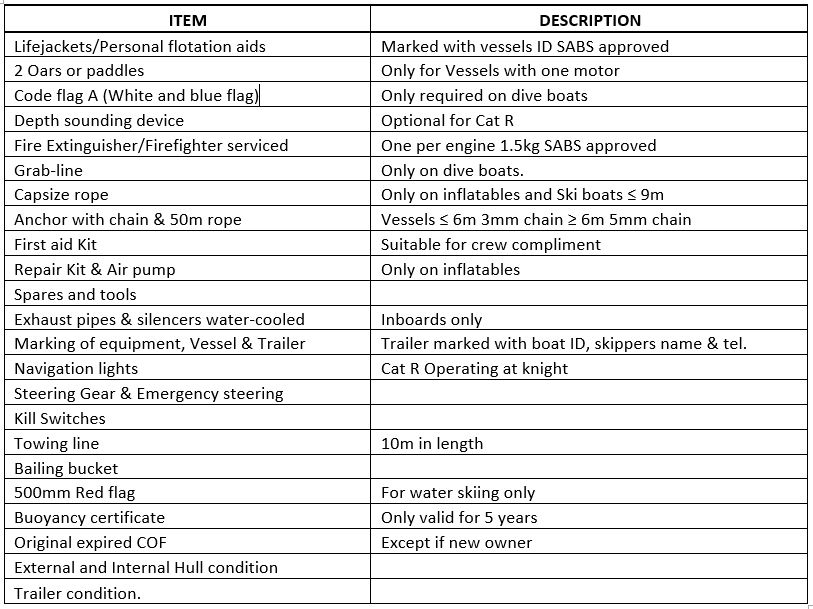Skippers Academy
COF (CERTIFICATE OF FITNESS)
Safety Survey Equipment Checklist for the certificate of fitness of a vessel
CAT R: Vessels operating in all PORTS, FISHING HARBOURS, TIDAL RIVERS & LAGOONS, ESTUARIES AND ALL INLAND WATERS IN SOUTH AFRICA.

Projective flare set Unexpired
Hand-held smoke marker Unexpired
29MHZ radio No VHF for Cat E ( D,C,B and A must have )
Drinking water 750mm drinking water per person
Navigation lights
Sea Anchor with hawser & tripping line
Must have whistle attached with lanyard.
Marked with boat ID.
Reflector strips intact and not faded.
Straps all there.
No loose stitching.
Foam not compressed.
SABS 1417/1987 & SAMSA approved.
Not faded.
Keep in good and clean condition and out of sun. Store in cool dry place
One Flotation aid or lifejacket of appropriate size to be provided for each person on board.
Cat R ——Vessel operating solely on inland waters. ( Now defined as all water areas accessible to the public and contained within Ports and Fishing Harbors, tidal rivers, lagoons and all rivers, dams and lakes in South Africa.
Cat E——- Vessels operating not more than 1nm from shore and 15nm miles from an approved launch site.
Cat D——-Vessel operating less than 5nm from shore ( Vessels with self-draining deck and one engine.
Cat C——-Vessel with twin engines operating less than 15nm from shore.
Cat B——-Vessels operating less than 40nm from shore.
Cat A——-Vessel operating any distance from shore.
Cat R vessels operating in inland waters must have a minimum of 30% buoyancy fitted. Crew not calculated in working out buoyancy to be fitted.
Cat E vessels operating 1nm offshore must have wet deck and a minimum off 60% buoyancy fitted, Crew effect must be added in calculation of buoyancy to be fitted.
Cat E, D, C, B and A: Watertight bottle with negative buoyancy to store all flares, COF, COC and Buoyancy certificate and emergency items.
Must be secured on bow of vessels with capsize rope around bottle and secured to vessels with lanyard for easy access in event of capsizing.
Capsize rope to be long enough to secure to engine with knots in rope for easy holding on to rope.
Red flag 500mm x 500m used when skiing.
“A” flag. White and Blue used when picking up divers.
“V” flag. White flag with red cross from corner to corner when in distress to get attention from other vessels.
All Vessels must be fitted with an emergency steering if there is no tiller arm to operate vessel when steering cable brakes
There must be an operational kill switch for each motor on the Vessel attached to the skipper. ( not to be used when doing surf launch )
Only approved steel, stainless steel or HDPF plastic tanks to be used.
All fuel tanks must have some form off determining how much fuel is in the tank.
Fuel tanks must be adequately secured and of adequate capacity.
Tank must be fitted with adequate breathers.
Must be stowed outside of engine and battery compartment.
When refueling beware of static electricity.
Requirement is one 1.5kg dry powder per engine.
SABS approved.
Serviced annually by an SABS authorized agent.
Installed close to skipper and engine.
It should be shaken and turned regularly so as to prevent the powder from setting hard in the container.
Fire fighter extinguishers are also approved by SAMSA (They are 225mm long and about 35mm thick.)
Adequate tools for the purpose of carrying out emergency repairs to machinery and essential equipment on board.
Tools like screwdriver set, set spanners, plug spanner, side-cutter and plier.
Adequate spares to do emergency repairs.
Tools like: Inline fuse and normal fuses, plugs, fuel filter, spare hull plug, rope to start engine in case of starter failing, priming pump, fuel line and spare impeller ( optional )